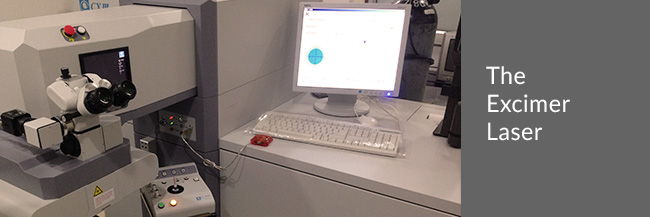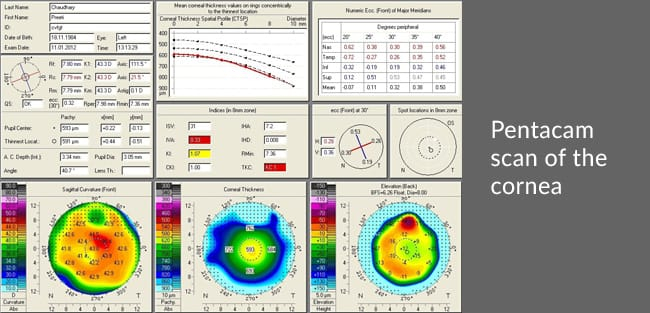Refractive Surgery is a laser guided correction of a person’s refractive error, minimizing or eliminating the need for glasses or contact lenses. Anyone who does not want to wear glasses or contacts, or feels visually, socially or functionally restricted by them may go for the surgical procedure. All types of refractive errors – myopia, hypermetropia and astigmatism can be corrected. The basic principle of the surgery is bringing about an alteration in the curvature of the cornea with the help of the Excimer laser that ablates it. This changes the optical power of the cornea.

Eligibility for Refractive Surgery
The following are some of the criteria that a person opting for refractive surgery must fulfill.
- Must be above 18yrs of age
- Must have a stable refraction for the last 6-12 months
- Must not have an ocular surface disorder like ‘dry eye’
- Should not have used contact lenses within the last 15 days
- Should have adequate corneal thickness
Before a patient is selected for surgery he/she is thoroughly examined by the doctor to exclude any contraindications. Besides routine examination, this procedure involves another test called the ‘Pentacam’ which is a detailed analysis of a person’s cornea- its shape, topography, thickness, elevations and abnormalities. It is only after this that the patient may be declared absolutely fit for refractive laser correction.

Wave-front guided Customized Laser correction
The Excimer Laser is used for refractive laser surgery. The wavefront laser is more advanced form of the Excimer. It scores over the latter in being a customized technique so that every surgical procedure is ‘tailor-made’ for that particular eye.
In this procedure, not only are the refractive errors corrected, but even the minutest of aberrations (called higher order aberrations) in the optical system of the eye removed, resulting in an improved quality of vision. The aberrations are detected by an instrument called aberrometer, and then both, the refractive error and the higher order aberrations fed into the laser machine. The laser then ablates the cornea in such a way that these aberrations are removed.

Various Techniques for Laser Refractive Surgery
The same laser is used to ablate the cornea in all different types of refractive laser surgery. However, the technique adopted for the procedure may differ. Commonly, three different types of techniques are used.
- Photo-refractive Keratectomy (PRK)
In this technique, the corneal epithelium is removed and the surface of the cornea ablated with laser. PRK has been in practice since the 90s. Patients experience some degree of pain during the first 48hrs and recovery is relatively slower.
- Laser Assisted in-situ Keratomileusis (LASIK)
In LASIK, a mechanical instrument called the ‘Microkeratome’ is used to raise a flap of corneal tissue. The laser is then used to ablate the cornea underneath the flap. The flap is then repositioned. The main advantage of LASIK is that there is no pain. However, occasionally, there might be flap related complications like button-holing, free flaps and corneal ectasias.
- Laser Assisted sub-epithelial Keratectomy (E-LASIK or LASEK)
This is a somewhat hybrid procedure between PRK and LASIK. Instead of giving a cut in the cornea to raise a flap, the corneal epithelium is raised with the help of alcohol. The corneal surface is then ablated and the epithelial flap replaced. The main advantage of E-LASIK is that it is a tissue conserving procedure – a mere 50 micron thick epithelium is raised so that corneal tissue is not wasted in creating a flap. Also, flap related complications as with LASIK are avoided.
- SBK-LASIK (Sub-Bowman’s Keratomileusis)
This form of laser refractive surgery is similar to LASIK in that the ablation is performed underneath a flap of normal tissue. However, the difference is that the corneal flap created is much thinner. Conventional LASIK utilizes a 130-180µ flap. The technique of SBK utilizes a 70-90µ thick flap. This gives the advantage of preservation of a greater amount of corneal tissue, which in turn may allow the correction of greater amounts of refractive error, if required, in addition to others.
- Blade-free LASIK
In the conventional technique of the LASIK procedure, surgeons use the blade of the microkeratome to create the corneal flap. With proper pre-operative screening, and careful surgery, this form of LASIK is generally safe. However, if complications do arise, the microkeratome is generally the cause. In the blade-free form of LASIK, this flap is created using the Femtosecond laser. It enables the doctor to make a customized and individualized flap, without a blade ever coming in contact with the eye.
Advantages of blade-free LASIK
- Better predictability
- Fewer flap-related complications
- Lesser induced higher order aberrations
- Reduces human error
- Individualized treatment
At Amritsar Eye Clinic, laser surgery is done on an out-patient basis. This means that the patient can go home immediately after the procedure. A relative or friend should accompany him/her. Usually, both eyes are treated at the same time.
Non-Laser based Refractive surgeries
ICLs
The term stands for “Implantable Contact Lenses.” One shouldn’t confuse them with the commonly used contact lenses. When an individual has a very high degree of refractive error (high powered spectacles), laser refractive surgery on the cornea becomes difficult or impossible. In such situations, an ICL may be resorted to. This lens is placed inside the eye through a small incision, in front of the natural lens, and helps to correct the refractive error. Since the natural lens is not disturbed, there arise no problems with accommodation and near vision.

Refractive Lens Exchange (RLE)
In this surgical procedure, the natural lens of the eye is removed and replaced by an artificial intra-ocular lens of a calculated power, such that it corrects the refractive error of the eye. It is usually reserved for select patients who have extreme degrees of refractive errors that cannot be corrected by other techniques.

